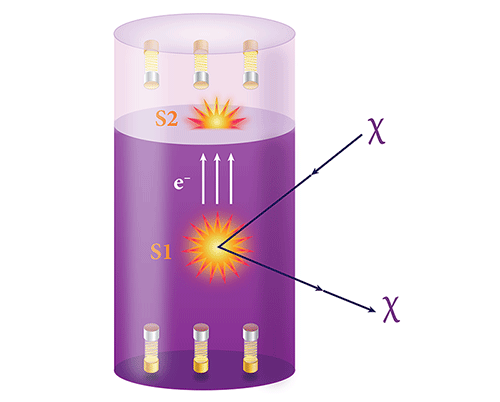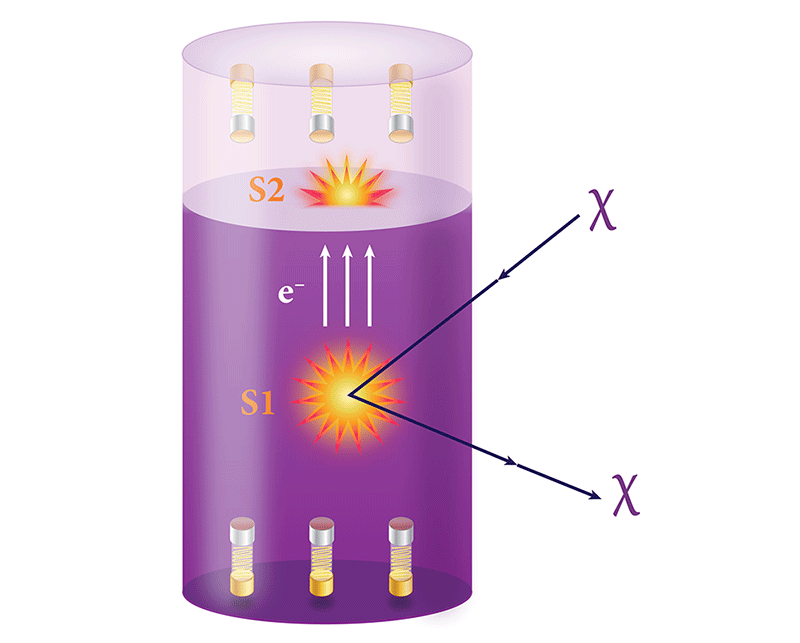Dark Matter Still at Large
Over 80 years ago astronomers and astrophysicists began to inventory the amount of matter in the Universe. In doing so, they stumbled into an incredible discovery: the motion of stars within galaxies, and of galaxies within galaxy clusters, could not be explained by the gravitational tug of visible matter alone [1]. So to rectify the situation, they suggested the presence of a large amount of invisible, or “dark,” matter. We now know that dark matter makes up 84% of the matter in the Universe [2], but its composition—the type of particle or particles it’s made from—remains a mystery. Researchers have pursued a myriad of theoretical candidates, but none of these “suspects” have been apprehended. The lack of detection has helped better define the parameters, such as masses and interaction strengths, that could characterize the particles. For the most compelling dark matter candidate, WIMPs, the viable parameter space has recently become smaller with the announcement in September 2016 by the PandaX-II Collaboration [3] and now by the Large Underground Xenon (LUX) Collaboration [4] that a search for the particles has come up empty.
Since physicists don’t know what dark matter is, they need a diverse portfolio of instruments and approaches to detect it. One technique is to try to make dark matter in an accelerator, such as the Large Hadron Collider at CERN, and then to look for its decay products with a particle detector. A second technique is to use instruments such as the Fermi Gamma-ray Space Telescope to observe dark matter interactions in and beyond our Galaxy. This approach is called “indirect detection” because what the telescope actually observes is the particles produced by a collision between dark matter particles. In the same way that forensic scientists rely on physical evidence to reverse-engineer a crime with no witnesses, scientists use the aftermath of these collisions to reconstruct the identities of the initial dark matter particles.
The third technique, and the one used in both the LUX and PandaX-II experiments, is known as “direct detection.” Here, a detector is constructed on Earth with a massive target to increase the odds of an interaction with the dark matter that exists in our Galaxy. In the case of LUX and PandaX-II, the dark matter particles leave behind traces of light that can be detected with sophisticated sensors. This is akin to having placed cameras at the scene of a crime, capturing the culprit in the act.
The heart of both LUX, located in South Dakota in the US, and PandaX-II, situated in Sichuan, China, is a time-projection chamber. This consists of a large tank of ultrapure liquid xenon—250 kg at LUX and 500 kg at PandaX-II—topped with xenon gas (Fig. 1). A particle (dark matter or ordinary matter) that enters the chamber and interacts with a xenon atom in the liquid generates photons (by scintillation) and electrons (by ionization). The photons produce a signal, S1, which is read by photomultiplier tubes located at the top and bottom of the tank. The electrons are instead coaxed into the gaseous portion of the detector by an electric field where they induce a second round of scintillation and a signal S2. The pattern of S1 and S2 signals is different when the xenon interacts with a dark matter particle than with an ordinary particle, which is what allows scientists to distinguish between two such events. To reduce the background signal from ordinary particles, both LUX and PandaX-II are buried underground to provide protection from cosmic rays. In addition, the use of ultrapure materials in the construction of the experiment cuts the background contributed by radioactive emissions.
The WIMPs, or weakly interacting massive particles, that LUX and PandaX-II were designed to seek are a theoretically favored dark matter candidate. This is because they are predicted by so-called supersymmetric extensions of the standard model of particle physics and could have been produced in the early Universe with the right abundance to explain astrophysical measurements. In the simplest WIMP models, the particles weigh many times the mass of the proton, with masses between 10 and 1000 GeV∕c2, and they interact with matter and each other via a weak force. Experimentally, the strength of this interaction is quantified by its cross section. The LUX and PandaX-II experiments are sensitive to a wide range of WIMP candidates from approximately 5–1000 GeV∕c2but they are most sensitive to WIMPs with masses around 40–50 GeV∕c2.
In their latest papers, LUX [4] and PandaX-II [3] report observing no WIMP candidates. Given the experiments’ sensitivities, this “null” result tells us that if the WIMP exists and its mass lies between 10 and 1000 GeV∕c2, its cross section for interacting with normal matter is less than an extremely small value. PandaX-II tightened this constraint on the cross section by as much as a factor of 2 compared to the previous best result in this mass range; LUX, which combined data from several runs, pushed this constraint even further.
If you lost your car keys, you might first check your coat pocket and, if you didn’t find them there, search your kitchen, the car, and so on. Similarly, the null results from LUX and PandaX-II have ruled out some of the parameters (mass, cross section) that could characterize dark matter, telling researchers at direct-detection experiments that they should look elsewhere. They have told us that dark matter interactions are much rarer than suggested by many popular hypotheses. Indeed, with these new null results and the lack of evidence for supersymmetry at the LHC, a number of physicists have started to question the WIMP hypothesis, at least in its simplest form.
To go beyond the constraints set by LUX and PandaX-II will require a second generation of detectors with larger targets and improved sensors. But fighting the background from ordinary particles will be a tough game: Second generation detectors will be affected by levels of radioactivity so low that only extremely clean materials can be used to build them. Ironically, future detectors will have such exquisite sensitivities that their background signals will be dominated by solar, atmospheric, and supernovae neutrinos—particles that other experiments have worked so hard to observe!
In the near term, the US Department Of Energy and National Science Foundation have invested in building a complementary suite of instruments. The LUX-ZEPLIN [5] experiment, which will take over for the now-completed LUX experiment, is designed to probe dark matter candidates with masses greater than 10 GeV∕c2, while the complementary SuperCDMS SNOLAB [6] and ADMX Gen2 experiments will probe particles with small masses less than 10 GeV∕c2. With the combined effort of these and other experiments, we are certain to understand more about dark matter in the next decade.
This research is published in Physical Review Letters.
References
- G. Bertone and D. Hooper, “A History of Dark Matter,” arXiv:1605.04909.
- P. A. R. Ade et al. (Planck Collaboration), “Planck 2015 Results. XIII. Cosmological Parameters,” Astron. Astrophys. 594, A13 (2016).
- A. Tan et al. (PandaX-II Collaboration), “Dark Matter Results from First 98.7 Days of Data from the PandaX-II Experiment,” Phys. Rev. Lett. 117, 121303 (2016).
- D. S. Akerib et al. (LUX Collaboration), “Results from a Search for Dark Matter in the Complete LUX Exposure,” Phys. Rev. Lett. 118, 021303 (2017).
- D. S. Akerib et al. (LZ Collaboration), “LUX-ZEPLIN (LZ) Conceptual Design Report,” arXiv:1509.02910.
- R. Agnese et al. (SuperCDMS Collaboration), “Projected Sensitivity of the SuperCDMS SNOLAB experiment,” arXiv:1610.00006.





